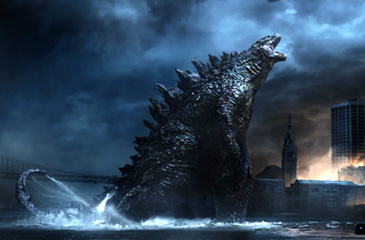Godzilla (2014)

British film director Gareth Edwards is no stranger to monster movies. After all, he put his name on the proverbial map with one in the low-budget, high-concept monster flick entitled, appropriately enough, Monsters in 2010. Edwards continues his exploration of a world in which humanity must deal with giant monsters in our midst with Godzilla, though viewer reactions will likely run the gamut from awful to great, depending on expectations going in.
After a brief intro set in the Philippines, Godzilla starts in a familiar place, Japan, where we find an American manager of a power plant named Joe Brody (Cranston, Argo) suddenly come to an alarmed state when he notices some strange seismic radiation patterns emerging in the area. His complaints aren’t unfounded, as calamity does strike. Fast forward fifteen years and we follow Joe’s son Ford (Taylor-Johnson, Kick-Ass 2), a U.S. Navy bomb disposal specialist, living in San Francisco with his wife (Olsen, In Secret) and son (Bolde).
Ford soon learns that dear old dad has gotten himself into hot water in Japan after the elder notices the same patterns beginning to emerge yet again, so the younger must head off to help fix the situation. While there, the two visit the old stomping grounds that have been quarantined for years and find that scientists there have discovered that there are gargantuan things of unknown origin there that have effectively eaten up all of the radiation from the power plant.
Eventually, a mammoth monstrosity with wings is hatched that the humans have named a “MUTO” (Massive Unidentified Terrestrial Organism), that begins to wreak havoc on manmade structures and vehicles as it goes in search of sources of nuclear radiation to feed itself. Meanwhile, another behemoth appears on the scene in the form of the long-dormant Godzilla, who emerges from its slumber in order to restore the balance of nature again.
Perhaps the greatest flaw of Godzilla is that of nearly every incarnation of “Godzilla” on the big screen, and that is that its script isn’t particularly good. Unknown screenwriter Max Borenstein (Swordswallowers and Thin Men) makes a fundamental error in judgment by making the creature of Godzilla himself merely a plot device to be utilized for a grand climax rather than the main story element. As Godzilla is off screen most of the time, we’re left with mostly the human actors to follow.
Unfortunately, while the cast is fine, the characterizations offered are barebones and generic, with each role merely there to either service the plot or to bear witness to events. While it’s refreshing to see a film in which the human ability to play heroics is futile, expending as much time as Borenstein does on these nearly irrelevant humans keeps us from the only interesting part of the film, which is what’s going on among the mile-high monsters roving over the cityscapes.
The most important element missing from Godzilla is excitement. There are many scenes of destruction, but there’s really no emotional connection to any of them, which is especially troubling given that what happens in the film is likely killing, or potentially killing, millions of innocent men, women and children who are in the path of these titanic monstrosities who walk through buildings as if they are sand castles.
While it is interesting to note the restraint that Edwards shows in not revealing to the audience every aspect of the beasts’ physique and powers, he also doesn’t really give us much else to watch for that is of interest other than the special effects. Edwards says he had been influenced by Jaws in this regard, and while it’s a nice touch, it’s a shame he didn’t also incorporate the depth of the characterizations and nuanced performances from Spielberg’s opus because that is the real reason that Jaws works so well.
Toho studio’s original 1954 Godzilla is rife with allegory on the dangers of nuclear weapons and their effect on mankind. While nuclear weapons abound in this 2014 reimagining, the underlying themes are pretty much washed away, as they serve almost solely as a MacGuffin to showcase more massive destruction for our viewing pleasure. And massive it is; the special effects are magnificent, though it does make one pause to think that all of these advancements in technology haven’t produced a more exciting adventure than those that featured a man in a rubber suit knocking down small-scale models of buildings and bridges.
Once the climax is over, Edwards has nowhere to go with the story, and pretty much resolves to throw up the end credits without the requisite resonance or poignancy to cap off all of the wanton destruction we’ve just witnessed seemingly without respite. In a way, that’s apropos, as there isn’t much in the two hours that precede the credits that suggest that Edwards is interested in anything above and beyond just having his CGI-crafted toys to play with as they rampage over land and sea, decimating everything they encounter along the way.
If the most prevalent compliment for a film is that it is better than Roland Emmerich’s 1998 version Godzilla, it is an indication that it has probably missed the mark in a very big way. Such a shame when Godzilla’s iconic roar is drowned out by sounds of the many yawns of dozens of theater patrons around you with high hopes for a rip-roaring sci-fi adventure worthy of the “King of the Monsters” title.
Qwipster’s rating: C
MPAA Rated: PG-13 for intense sequences of destruction, mayhem and creature violence
Running Time: 123 min.
Cast: Aaron Taylor Johnson, Elizabeth Olsen, Bryan Cranston, David Strathairn, Ken Watanabe, Sally Hawkins, Richard T. Jones, Juliette Binoche, Carson Bolde
Director: Gareth Edwards
Screenplay: Max Borenstein
